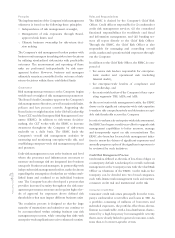American Express 2004 Annual Report Download - page 38
Download and view the complete annual report
Please find page 38 of the 2004 American Express annual report below. You can navigate through the pages in the report by either clicking on the pages listed below, or by using the keyword search tool below to find specific information within the annual report.
setting near-term customer asset value growth rates
based on a long-term view of financial market perfor-
mance as well as actual historical performance. In peri-
ods when market performance results in actual
contract value growth at a rate that is different than that
assumed, the Company will reassess the near-term rate
in order to continue to project its best estimate of long-
term growth. The near-term growth rate is reviewed to
ensure consistency with management’s assessment of
anticipated equity market performance. Management
is currently assuming a 7 percent long-term customer
asset value growth rate. If the Company increased or
decreased its assumption related to this growth rate by
100 basis points, the impact on DAC amortization
expense would be a decrease or increase of approxi-
mately $50 million.
Management monitors other principal DAC assump-
tions, such as persistency, mortality, morbidity, interest
margin and maintenance expense levels each quarter
and, when assessed independently, each could impact
the Company’s DAC balances. For example, if the Com-
pany increased or decreased its interest margin on its
universal life insurance and on the fixed portion of its
variable universal life insurance products by 10 basis
points, the impact on DAC amortization expense
would be a decrease or increase of approximately $5
million. Additionally, if the Company extended or
reduced the amortization periods by one year for vari-
able annuities to reflect changes in premium paying
persistency and/or surrender assumptions, the impact
on DAC amortization expense would be a decrease or
increase of approximately $20 million. The amortiza-
tion impact of extending or reducing the amortization
period any additional years is not linear.
The analysis of DAC balances and the corresponding
amortization is a dynamic process that considers all
relevant factors and assumptions discussed above.
Unless management identifies a material deviation
over the course of the quarterly monitoring, manage-
ment reviews and updates these DAC assumptions
annually in the third quarter of each year. An assess-
ment of sensitivity associated with changes in any
single assumption would not necessarily be an indica-
tor of future results.
CONSOLIDATED LIQUIDITY AND CAPITAL
RESOURCES
Capital Strategy
The Company generates equity capital primarily
through net income to fund current needs and future
business growth and to maintain a targeted debt rating.
Equity capital generated in excess of these needs is
returned to shareholders through dividends and the
share repurchase program. The maintenance of a solid
equity capital base provides the Company with a strong
and stable debt rating and uninterrupted access to
diversified sources of financing to fund growth in its
assets, such as cardmember receivables and loans and
other items. The Company maintains flexibility in its
equity capital planning and has developed a contin-
gency funding plan described below to ensure that it
has adequate sources of financing in difficult economic
or market environments.
The Company believes allocating capital to its growing
businesses with a return on risk-adjusted equity in
excess of their cost of capital will continue to build
shareholder value. The Company’s philosophy is to
retain earnings sufficient to enable it to meet its growth
objectives, and, to the extent capital exceeds invest-
ment opportunities, return excess capital to sharehold-
ers. Assuming the Company achieves its financial
objectives of 12 to 15 percent EPS growth, 18 to 20 per-
cent return on equity and 8 percent revenue growth, on
average and over time, it will seek to return to share-
holders an average of 65 percent of capital generated,
subject to business mix, acquisitions and rating agency
requirements. The Company exceeded all three of its
long-term financial objectives during 2004 and
returned to shareholders, through dividends and share
repurchases, approximately 87 percent of capital gen-
erated. The Company paid dividends of $535 million
during the year ended December 31, 2004. Since the
inception of the Company’s current share repurchase
program in 1994, approximately 68 percent of capital
generated has been returned to shareholders.
The Company maintains sufficient equity capital to
support its businesses. Flexibility is maintained to
shift capital among business units as appropriate. For
example, the Company may infuse additional capital
into subsidiaries to maintain capital at targeted levels,
which include consideration of debt ratings and
regulatory requirements. These infused amounts
can affect both Parent Company capital and liquidity
levels. The Company maintains discretion to manage
these effects, including the issuance of public debt or
the reduction of projected common share buybacks.
Additionally, the Company may transfer short-term
funds within the Company to meet liquidity needs,
subject to and in compliance with various contractual
and regulatory constraints.
AXP
AR.04
36
Financial Review
























